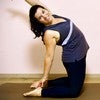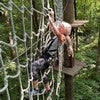Description
About This Video
Transcript
Read Full Transcript
Hi, everybody. It's Amy havens here at Pilates anytime. So happy to be back with everybody in the room in front of this window in the ocean. I am on the spine corrector. This is a short and sweet segment. I love the spine corrector for so many reasons, but one reason is to really provide mobility in our thoracic spine. Right? And so we've got our major lungs and our heart in here, big organs, but we also have an airway that needs to stay open for breathing properly and effectively efficiently.
So that's it's a short and sweet. I want you to use your spine correctors. If you don't have a spine corrector, you can use a stack of pillows and sit in front of the stack of pillows. You can sit on a yoga bolster, a half an arc, or even the floor, but I just want us to practice getting into our thoracic spine and feeling some, freedom of breath and mobility up in the upper spine. Alright. So I'm sitting in my, down in the crevice with my feet together, soles of feet together. You don't have to pull yourself all the way in.
Make it comfortable, but then not just loose your legs. So if you can gather up a little bit of strength in your inner thighs, sit in a comfortable position in as vertical alignment as you can, not forced It's not about rigidity. Okay? So we're gonna warm things up. One of the things I love about this is we need to strengthen the neck. In this world that we're living in, but we also need mobility and and kind of, suppleness in the skin and muscles around the neck.
I think you might agree. So let's start this way. You'll place your hands on your sternum one over the other, and this is a very light drawing down on your skin, you can kind of traction that. And even that starts to stretch the muscles through your neck and your collarbone area. And then very gently, everybody raise your chin and your jaw line up a little bit.
So there's a very large muscle group, and they're the platysma. Alright. I won't go mussels too much today. Just notice what you feel there. Take a breath or 2. Spine corrector, freedom, alignment, open the airway. We need alignment to get that clear for you, okay, and the head and the neck are essential.
So Let's bring your head back to center. We're gonna do that again. I want you to cross the other hand on top. It does feel a little different. Slightly tugged down.
And as you raise your jaw on your chin line, feel that if you can concentrate on your upper back, And what do you possibly feel? Maybe nothing. Hopefully something and it exists in between your shoulder blades where I want you to feel. It's not grip. It's not tension. It's awareness.
Okay. There were some I call those the roots of our neck, the muscles down in between the scapula. So gently, everybody rotate your chin and your jaw line left and right. Nothing too exaggerated, lightly pulling down with your hands. So bringing awareness to the neck before we work the muscles is our sequencing here. Just easy and then center your head.
You can let your hands go and just feel what you feel. K. Some isometrics for the neck. So take one of your hands and then just place it on either side of your head. I'm gonna do right hand on right side of skull by my temple. And what we're doing with this is it's an isometric.
So your head presses your hand your hand presses your head. It's not your maximum effort, but enough that you're noticing, wow, there there's some change in the tissue there in the recruitment of the neck. So the roots of our neck go in and down and keep thinking right between your shoulder blades. K. If your head is forward, if you know that to be true with you, you may not know that's you. If it is you and you know it, We want that head back over the spine so that the back of our skull is really aligned over our mid back and our sacrum keep pressing.
Is feeling the awareness of that isometric contraction. Okay? And then let your hand go. Notice what you notice. You'll hear me say that a lot, other side, and it's enough to feel it, not enough to hurt. Never, never. So head to hand, hand to head, I'm gonna take a few breaths.
So when our head is forward, which it is a lot in the world we're living now, the airway to breathe is not fluid. It's not open. It's not aligned. So to get efficiency in the way our spine moves, we organize the head in the neck that clears the airway, allows us to breathe more effectively, efficiency with recruitment of muscles, lungs, organs, all that. Okay. And then we'll relax that and just notice what you notice. We have 2 more parts of our neck. We're gonna put the hands in the front And you can do either hand in on in the front. Okay.
Now the invitation would be this to take the head to the hands. That's not where we're going. We just talked about that. So we keep the head over the spine. It's lightly head forward to hands, hands to head. Notice what you notice.
This one, really, for me, my body gets me right in touch with the two sides of my neck and down in between my scapula. Okay. You might wanna lower your shoulders just in case they're hiking up in your ears. Alright, everybody. We're letting go of that, and we have one more. You see us do this a lot in Pilates classes or hands behind the head.
You can interlace your hands. And you hear this one a lot from many of us head into hands, hands into head. The hands get to do something else in this shape in this position. They kinda scooping the skull up. Isn't that nice? And then lightly press a head back and just notice what you notice.
The roots of our neck down in between the shoulder blades in that mid upper back. Okay. Great. Just relax that. So you're aware. You've got some muscle awareness. Now we change the energy of, like, wake up everything.
Make wake wake wake. So tapping. Tap your sternum. Tap your ribs. Tap your neck a little bit. Tap your shoulders.
There's nothing specific here tapping or waking up a little more of your proprioceptive sense. And then notice. Now we get some breathing. Hands on your ribs. And, you know, ribs are interesting because some of us have a very long rib cage. Some of people have a shorter rib cage.
Where I want you to put your hands is way up high by the sides of your breast tissue, way up there. And press lightly right on the side of the lungs, press enough that you feel yourself pressing. And then as you take that inhalation, you're expanding into your hands, as you exhale, you press your hands just a little bit. So there's muscle in there, your nail. Fill your lungs and exhale. Couple more.
Where is your head? Well, if it was here, just bring her back, bring it back. Head over shoulder, shoulders over his torso torso over pelvis. So you wanna really feel your muscles of your rib cage expanding your ribs, pushing into your hands, exhale one more time with both hands. Now choose one hand. You're just gonna set one down.
You've got one lung now. Focus on this lung. A little more than the other one. We'll do 3 each side. So how can you isolate ice some kind of ice some late that side to inflate and exhale one more time. Breath.
Mister Pilates said, when in doubt, teach breathing, and breathe and exhale close other side three times, and I firmly believe in that. And when we're taking the time to to breathe and notice, there's a lot of muscle recruitment through the ribs, through the spine muscles. And invigorate the spirit. And exhale. Okay. One more breath. Big, big, big, sideways, front, back. And then exhale and just relax that down. Okay.
Interesting. Right? So just notice what you're noticing, maybe some awareness through your torso. Now place your fingertips lightly on your sternum, and you can walk your hands down to the very end of your sternum, right, before your ribs go sideways there. And then just lightly walk your hands all the way up to the top of the sternum, right, where it meets the collarbone. So there's two joints there. There's a lot of joints in here, but we're gonna find the fingertips right between the breast tissue. And I want everybody to lightly press in with your fingertips. And We know this is forward flexion or flexion of the spine.
Just let your rib cage yield back. It should feel like a gentle stretch of your back and your, you know, your spine, but also maybe the heart is going back the lungs are coming around the heart. I like that image. And then if we do the opposite extension, I'm going to reach the heart toward my fingertips and let the lungs kinda go back here imagery and my heart forward and up ish. Let's put a little breath with that so it exhale as we flex.
Oh, man. That feels yummy. Inhale. Couple more just getting this theme. Okay. So the spine can flex. We know this. The spine can extend. The sternum and the ribs are really well attached here, so we want mobile c and then one more extension.
Okay. So really easy this term this word is circum locution. It means circular. So here's generally what I want us to do. Bend to the side. However, that feels. Bend forward, bend to the other side and bend back a little bit.
And just go twice more same direction. Very gentle right now. Later at the end, we will do a bigger one. Okay? But you're getting the scent sideways. You twist a little to come forward.
Twist a little to go to the side and you rotate a little to come back. Now it'll go the other way. So it's just back. Where's your heart and lung going forward in and back? Opening a little to the side.
Two more. Feel fine to touch your sternum, touch the top of your head, a little awareness cues, And one more time. So this circular motion of spine ribs, etcetera. Okay. Good. What do you feel? Now let's come up and sit at the very edge. If you're on your cracker, you're coming all the way up. If you're on the floor, you're just probably me's bent put your hands behind your knees.
If you're on a bolster, you're right at the front of the bolster. So let's contract now. That was a lot of awareness and opening. I want us to contract the buttocks muscles, the abdominal muscles, and let your back widen Okay? Let your back widen. And then as you sit tall, the lumbar spine, the low back spine is just gonna kinda come in and up.
So as we contract the butt muscles, the glutes, and the abdominals, there's a there's a widening and lengthening of our back. It affects everything all the way up. And then come back to sitting tall. So if we put that exhale that we did earlier, that Heart going back, the lungs coming around the heart, inhale, maybe the heart goes forward and up. But keep working with the muscles of your hips, the abdominals, and opening your lower back. We'll do 2 more here, everybody.
Really gentle. Contract your glutes. Contract your abdominals. Open your back. And lift. And one more time and contract and contract and open your back. Now I'm gonna have you stay with this.
Reach your hands forward and then just slowly or hold your correct edges come on back to the very back of the back. Right? If you're on your bolster, you're on the back of your bolster, if you're on the floor, you're all the way on the floor. Okay. But what we're doing next is gathering the legs together and then I'm scooting forward. I wanna make sure that as I go over, my back is secure. My head is on the barrel. Or on the bolster or floor, and you don't feel vulnerable in any place of your spine.
You're well supported. Okay? So we're just putting your hands on your abdomen for a moment. Breathe wide across the collarbone and your chest. If you wanna tap a little, keep awareness there, that's fine.
Just this sheer nature of the arc of this barrel provides this supported back position to open up your posture, open up the collar, the chest, the width across the front of you. Okay. But we're gonna carry on and do some more mobility for the shoulder girdle, which affects the thoracic spine. It's all again to continue clearing that airway for better breathing. Your head is back where it should be. So let's start with open close arms. Sometimes you'll hear us say chest expansion.
So it's a big wide expansion of your arms. Take a breath there. And then exhale is you raise your arms up just shoulder width apart. Let's go for 5 or 6 of these inhale. A lot of energy.
I do like to think about not just my muscles, but the lung organ itself expanding into my arms. 3 more times big in. Shoulder blades stay flat back on the barrel 2 more times. And close, breathing life into this upper body here, everybody, and close. Okay.
Alternating arm reaches. So a scissor. Sometimes I call it the scissor. One arm comes down by our hip. The other one is back alongside the ear somewhere in that vicinity, you wanna make sure that shoulder blade though is pressing on the barrel and that the ribs are just where they need to be or not thrusting them forward.
And change. And I'm gonna keep looping us back to what the purpose of this little segment in this opening your airway. Notice how you might be able to breathe a fuller, more complete breath here. You've got the support of this apparatus. It's helping us achieve that expansion of the lungs.
Why do we wanna breathe so big? We want more oxygen in our blood, in our body. Good. One more each side, and then we get arm circles. And arm circles So fun. I'm gonna have you start with your arms just straight up above your body. You can turn your palms to face your legs.
I'm gonna close my hand. It just feels good to me. You can keep yours open. Let's begin with reaching our arms both back alongside the ears. Now hold that position for a moment and press your shoulders back again your, barrel or floor or bolster and nestle your rib cage in against your the front ribs against you a little bit, everybody.
Feel the difference and then open your arms wide into that open position again, come down by your legs, turn your palms down. Just three each direction. We don't need many. I want you to expand your wings. How wide can you stretch those arm wings that you have?
Right? So the breath might be your help or your facilitator. Breathe. Breathe. Breathe. And down. Now the reverse will be palms face up.
This is quite delicious right there. Getting that big arc. That's an inhalation exhaled down. So these big arm circles are coming in handy for the bigger circumlocution that we're going to do momentarily. And open.
It's just a wonderful way to get mobility in the upper back with support. Okay. I want you to lift your head. That's an interesting moment. Bring your knees into your chest, and hug yourself. Give yourself a big hug.
Stretch your body forward. I'm bringing my chest toward my thighs. Thied toward my chest. It was a great stretch. And then we're coming back up We're gonna sit back into the crevice that we did at the very beginning.
You notice any energy change? I do. Okay. Bigger circle mocution. Let's start with our arms out. And want you to take one arm up above your head by your ear and bend to the side. Let's breathe into that lung.
Big inhalation. Exhale bring yourself center, other side. Big lung breath. And exhale again. Think about the lung and the lung. We'll do one more each direction, big inhale, and exhale, and then Okay? We're gonna go forward and back.
Keep your arms open. Take a breath. Exhale this way heart goes back. Inhale heart goes forward. Exhale heart goes back.
Heart goes forward. 2 or 3 more. Heart and heart. And the heart. And then the big movement We gotta go around the world like we did earlier over and forward. You can think about this from the outside making shapes, you know, the arms moving, or go inside, breathe the lungs, move that heart, right lung. Heart goes back.
Left lung. Heart comes forward. One more this direction. Big orbital Circumocution motion other way and over. So the thoracic spine gets kinda stiff if we don't move it this little segment gave you a just a sprinkle of how this thoracic spine can move, how we can put it, into a little more motion and revitalize, refresh restore, and, hopefully, do you feel like you can breathe a little better?
It's just me. Hope it's not just me. Let me know. Thanks for joining me, and I'll see you next time.
Comments
You need to be a subscriber to post a comment.
Please Log In or Create an Account to start your free trial.

























